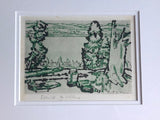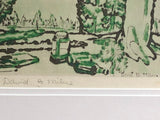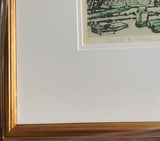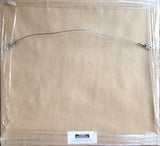David Brown Milne [Canadian, 1882-1953]
(CGP, CSPWC, CSGA)
Painting Place (Hilltop)
4 3/4 x 6 3/4 inches (12.1 x 17.1 cm)
signed 'David B. Milne' in pencil in the lower margin & signed in the plate.
Two-colour drypoint from two plates.
Framed. 15 x 16 1/2 inches (38.5 x 41.6 cm)
State 3 of 6 (the catalogue raisonné lists 6 states but 8 are now known). TOVELL 63.
"Painting Place" was commissioned and published by The Colophon in 1931, Part V in a total edition of 3000 (with an extra 100 in case of damage). The estimated size of each state was between 300 and 350 impressions. The print was originally published under the title "Hilltop" - see TOVELL, Reflections in a Quiet Pool: The Prints of David B. Milne, Ottawa: 1980, 63 pp. 150-151; TOVELL, David Milne Painting Place, Ottawa: 1976 & SILCOX, Painting Place: The Life and Work of David B. Milne, Toronto: 1996;
_______________________________________________________________________________________________________
David Brown Milne [1882-1953] Born near Paisley, Bruce County, Ontario, the sixth and youngest child of the Milnes, parents of five sons and one daughter. They moved to the town of Paisley when David was still an infant. There the family lived a frugal existence from the produce of a small market garden and a home laundry. David was much younger than his nearest brother and probably spent many hours by himself. He started drawing with great enthusiasm before he entered kindergarten. His interest in art continued by after graduating from the Paisley high school he came a country schoolteacher. After several years he decided to study painting in New York City. With borrowed money from his brother Jim and some of his own earnings, he travelled there and enrolled in a school which closed shortly afterwards so he entered the Art Students' League in 1903. For six months he studied under George Bridgman and Frank V. Dumond and afterwards continued studies part time while gradually developing his art. When money ran out he turned to commercial art to support himself. He canvassed shops throughout Manhattan Island for orders to make signs, showcards, window dressing, and he also did some illustration work which he was an arduous experience for both publisher and artist. His earnings were meagre and often he ended the day by cooking an egg over a gas jet (for lighting) by standing on a chair. During his struggles he met another aspiring painter names Amos Engle and they pooled their resources by sharing a loft over a Greek restaurant on East 42nd Street. Although they were materially poor their experience was rich with learning and excitement. They attended all the famous exhibitions like presentations by Durand Ruel (dealer to the French Impressionists) or shows at the Stieglitz Gallery 291 owned and operated by the famous American photographer who first showed the art of Rodin and Matisse in 1908 and later paintings by Cezanne, Picasso, Toulouse-Lautrec and American artists like Demuth, Dove, Harley, Martin and much later O'Keefe (whom Stieglitz married). They witnessed the rebel exhibitions of The Eight. The work of Maurice Prendergast, one of The Eight, was of special interest to Milne. Deeply involved with experiments in impressionistic painting, Milne was particularly influenced by Prendergast and the French Impressionists Monet and Seurat. He applied patches of paint in a almost mosaic or sometimes quilt-like fashion for a decade or more. During his stay in New York he exhibited his paintings in various exhibitions including the American Water Colour Society; Pennsylvania Academy and Spring and Autumn shows at the Montross Gallery. His work was noticed by James Clarke, an advertising artist, while viewing an exhibition with fellow artists. Clarke was so impressed with Milne's work that he decided to track him down. He located Milne and Engle living in their quarters above a Greek restaurant around the year 1912. In the Tears that followed Clarke became Milne's patron and closest friend. In 1913 five of Milne's paintings were chosen for the exhibition in the Sixty-ninth Regiment Armory, New York City. This huge show was arranged under the auspices of the Association of American Painters and Sculptors and included works from Ingres through to contemporary art of Europe and America. In all, thirteen hundred pieces of art where shown including paintings by three Canadians, Ernest Lawson, Arthur Crisp and Milne. Milne's contributions consisted of five paintings: "Little Figures", "Distorted Tree", "Columbus Circle" (now "Billboard"), "The Garden" and "Reclining Figures". Of these "Columbus Circle" or "Billboard" was acquired by Douglas Duncan and then the National Gallery of Canada. Working as a window dresser Milne did jobs for a drug store in which a bookkeeper Patsy Hegarty, was employed. They enjoyed one another's company and after six years were married. During Milne's stay in New York he made weekend trips to the country where he must have pondered a better life away from the city. He spent the summer of 1915 in the Catskill Mountains and this experience convinced him more than ever that his survival was to be had only in the country. They left New York City in 1916 because of the increase in economic pressure and settled at Boston Corrners near Millerton, N.Y. eighty or so miles north of New York City. By then the First World War had been raging for four years. He decided to return to Toronto, in 1918 and enlisted in the Canadian Army as a private. After regular training he arrived at Kinmel Park Camp, near Rhyl, North Wales, where he was taken on permanent staff. The camp was a segregation point set up in 1918 for quarantining incoming drafts from Canada against infectious diseases, and for testing their general readiness before moving them to advanced training battalions in the south of England. While at this camp Milne became aware of a programme of employing artists (the hiring was done by Paul Konody). He cabled a friend (probably Clarke) to rush thirty of his paintings to England as he was required to show samples of his work. The paintings were viewed and Milne was chosen as a war artist. In the spring of 1919 he was formally taken on the strength of Headquarters, Overseas Military Forces of Canada, London, and after having completed thirty-seven painting in various camps in England he sailed for France with the status of official war artists and rank of lance-corporal. He went directly to the Vimy-Arras area where he remained until the end of July, 1919. Next he painted in the Ypres-Passchendaele area, and the Somme. Of the seventy paintings he did on the Continent, fifty-two were done in France and eighteen in Belgium. He returned to England briefly then sailed to Canada on the S.S. Belgic and was released from the army in Toronto on October 14, 1919. R.F. Wodehouse, curator of War Art, NGC, noted his work as follows: "Milne's war paintings, all in drybrush watercolour technique, reveal the aftermath of war; very seldom, if at all, do they convey it drama or horror, The devastated buildings, battlefields, views of military camps and towns are depicted in an elegant, tasteful and clean manner. These paintings represent a personal vision of things seen after the cessation of hostilities rather than a graphic description of the path left by war. At the outset Milne's style was rater tentative but quite rapidly crystalized into a highly individual idiom which remained almost unchanged long after the time he was a war artist." Milne returned to Boston Corners in December of 1919 and to his painting. But within a year he ran out of money. Patsy went to work in N.Y. as a clerk during the winter and they also got a loan from James Clarke. David remained at Boston Corners in a hut he build of saplings, tarpaper and moss, where he continued to paint. The Milnes then found jobs at Big Moose in the Adirondacks in a summer resort. David built a shack there from an abandoned carpenter's locker. Then for the next two summers they stayed in a newly bought cottage of James Clarke in exchange for some carpentry to the interior. In the summers they rented a cottage which Patsy then ran as a tea room but in the fall of 1923 David was off to Ottawa with the hope of starting a painting class. Once there he had trouble finding students. Patsy settled in Montreal where she found a job as a housekeeper-companion and in here spare time tried to interest Montreal art dealers in giving David a solo show. He made trips to Montreal periodically. Finally The Art Association of Montreal agreed in 1924 to exhibit eighty of his watercolours. No paintings were sold at a time wen they badly needed the money. In Ottawa however he managed to sell six watercolours to the National Gallery of Canada and his work was chosen for showing at the British Empire Exhibition at Wembley (1924-25). During his stay in Ottawa he painted scenes of the city from his hotel room and from the Hull side of the Ottawa River. The Milnes returned to the United States in the spring of 1924, secured another loan from Clarke and purchased a lot at Big Moose and built a house which took several summers to complete. David spent weeks cutting large slabs of stone out of a boulder for their fireplace, installed the wiring, carved trillium shaped reflectors and other decorations. Finally the living room could be used for a tearoom to help provide them with some income.They also ran a ski canteen at Lake Placid for several winters for added income. Their tearoom venture lost money, David did mange to do a number of sketches around Lake Placid which he made into colour drypoints (see NGC Coll. from D. Duncan). His first prints were in two or three colours reproduced on copper sheets (purchases from a hardware store). His first printing press was an ordinary washing machine wringer. Then James Clarke gave him an etching press with the understanding that Clarke himself would receive one print of everything Milne did and the use of the press on occasion. In 1929 the Milnes sold their house and left everything behind at Big Moose with David's paintings now close to two thousand. They moved to Canada and spent the summer at Lake Temagami, Ontario and the winter at Weston. Then they moved to Palgrave, northwest of Toronto, where they used as furniture, the packing cases in which Milne shipped his paintings from Big Moose. The Market crash of 1929 affected nearly everyone The purchaser of their house at Big Moose was unable to keep up regular payments which put the Milnes short of money. Living was hard, food was scare, but David kept on painting. In 1934 he wrote either the National Gallery or Vincent Massey proposing a scheme for the sale of a large number of his works as a collection in itself. Although the scheme was not fully realized, Massey bought most of his paintings done between 1929 and 1924 (his Canadian period) and then organized a one-man show of Milne's work at the Mellors Gallery, Toronto. It was through this show that Milne found new patrons. By then he was living at Six Mile Lake, near Georgian Bay, by himself. It was around this time that Kenneth Wells of The Toronto Telegram related the following story, "S.S. Finlay, of the Northern Vocational School, came upon him (Milne) over a year ago, as he paddled his canoe down the grey-green waters of the Severn. 'We came around a bend in the river,' says Mr. Finlay, 'and we came upon a man no longer young, but not old, sitting in his canoe and painting. We learned that he had come from Owen Sound way- Tom Thomson's boyhood stomping ground, you know - that he had purchased his canoe, second-hand in Orillia, and was finding life on the river pleasant and cheap. We looked at his sketch. It was quite good. we said good-day and passed on.' That was last summer. This summer Mr. Finaly was back up in the country of grey-green water and red stone, ... 'I was laying back, reading,' he said, 'when the door opened and a man tramped in. He was brown as a nut, dressed in well-worn rough clothing, and wearing shows that threatened to splinter the floor. I looked at him a second time. It was my friend of last year... this man of the towns had gone into the woods and built himself a cabin. With equipment that would had disheartened an Indian, and with next to no money, he had cut down trees, built a cabin, lived the winter, and found spring come around again with the love of life still in him. It was his greatest boast that not once had he to wear his overcoat to bed, and that he had been able to get the door to is cabin before Christmas, He's strong, and intent, and no man is his master. What more could he buy with a million?'" At one time, Milne visit a country school where he developed a rapport with the children drawing upon his early experiences no doubt when he was a schoolteacher. He became interested in how a child might imagine religious themes free from the traditional religious art. From his experience and others he painted series of illustrations for Bible stories as humorous fantasies and he treated other subjects in the same way. A number of them were purchased by Douglas Duncan and later acquired by public galleries. Many of these fantasies were painted in the early forties. In 1935 Douglas Duncan and Alan Jarvis having seen Milne's paintings at the Mellors Gallery decided to pay him a visit as Six Mile Lake. Both Jarvis and Duncan later became his life long friends. Duncan began to exhibit his paintings annually at the Picture Loan Society in Toronto. The Mellors Gallery continued to exhibit Milne's work until 1938, then Duncan became his agent. He assured Milne of a fixed income by making a series of personal purchases in addition to the regular sales made at the Picture Loan Society. Jarvis then aged 21 wrote what was probably the second formal article on Milne for The Undergraduate (University of Toronto paper) in 1936 (Buchanan wrote the first). He noted, "Milne is concerned primarily with line and pattern. His method is, therefore to brush in, in detail, all the line first and this drawing is made 'more readable' by the addition of values and colour. The scheme of values which Milne employs consists of two dark values (ivory black and near black), two middle value greys and two light values (zinc white and off-white). "If drawings could be made completely readable by the use of values', Milne has written, "there would be no need for colour.' Since line and values alone are not sufficient Milne employs a limited palette of six or seven hues. He uses eleven raw pigments for which he derives the six values and the hues proper: warm green, a variable yellow, warm red and cool red, a variable purple or violet and a constant blue. To heighten the forcefulness of his compositions Milne developed a number of original pattern-schemes the most notable of which is the use of blank space." Twenty-six years afterwards Jarvis produced the book David Milne as part of a series of books on Canadian artists. Just three years before Milne's death, Donald W. Buchanan wrote the following: "For years David Milne lived alone in the woods of Muskoka in a tiny hut, which was protected from the elements by only a few strips of tarpaper. But he was content. Although his income was meagre, he still had enough to pay for oils and canvas and for paper and paint for his water-colours. On arriving by canoe to visit him in his isolated abode, you would be welcomed by his warmly; then, given by chance, he would talk about art and criticism, about books and exhibitions, and go on to relate his memories of the great paintings he had seen years before in New York and Europe. When he had reached the peak of his enthusiasm, he would speak in praise of John Constable, who had produced 'art one could really believe in.' Not, mind you,' he would continue, 'Constable's heavy paintings, his large gallery pictures' - and he would pause to mention how Constable had lived in society weighed down with the desire for material possessions and had tried to confirm to it by exhibiting canvases made to Academy measurements - 'but those little sketches that he produced wen he was himself, they are worth everything else he ever did.' In such works was Milne's own personality revealed. The pursuit of plenty of time to himself, to muse upon the pattern of the forest outside his door or upon arrangements of bowls and bunches of wild flowers in his hut - time, too, for painting them again and again in compositions set down lightly and quickly, with compression of feeling and economy of means. So, partly in order to save money and partly to have all the days and honours he wanted for painting, he had taken to the woods to live, first on the shores of Lake Temagami in northern Ontario, then, after a brief period in a farming village, in this one-room cabin in a remote corner of Muskoka, a few miles from Georgian Bay, where he dwelt from 1932 to 1939. 'Since art us aesthetic emotion, exhausting, to be sustained intensely for only a short time, the more quickly readable a picture is the greater its power,' he once wrote. Over the years he has sought to perfect a technique which would give these results. The method he achieved was based partly on a broken impressionist line, useful in illustration, which he picked p at an early stage, before 1910, about the time he finished his studies in New York. Taken by itself, this method was superficial enough, but developed ad elaborated as it was by Milne, it soon became something both intimate and at the same time compelling in the vary briefness of its visual references. This can be seen from the water-colour The Mountains, 1917 (NGC) which was done in 1920 in the Adirondacks. In the most characteristic work, he tends to note the actual scene before him in a few sensitive lines of drawing, then he adds an almost mathematical balance of large areas of white and black or other dark values, and finally enlivens the compositions with many small and delicate touches of local colour. The colour he uses, however, are rarely linked directly to Nature; he often employs the, more often for decorative than for realistic effects. This cool and intellectual approach of his is the product of long years of thought and reflection, of years of solitude devoted to the study of his craft." In 1939, David and Patsy Milne parted. That same year he left Six Mile Lake and settled at Toronto for the next fourteen months. Then he moved to Uxbridge where he lived from 1940 to 1952. He spent six autumns at Coboconk (Gull Foot Lake) in the West Haliburton district of Ontario. He married Kathleen Pavey a registered nurse and they had one son, David Milne Jr. In 1952 he moved to Bancroft, Ontario, and he suffered a stroke in November and died at Baptiste Lake the day after Christmas in 1953. One man shows of Milne's paintings include: Cornell University, Ithaca, N.Y. (1922); Art Association of Montreal (1924); Mellors Gallery, Toronto (1934); James Wilson & Co., Ottawa (1935); Mellors Gallery, Toronto (1935-1938); W. Scott & Sons, Montreal (1935); Picture Loan Society (1938-53); National Gallery of Canada, Ottawa (1955, circulated); The Agnes Etherington Art Centre, Queen's University, Kingston, Ont. (1967 shown at LondAG; WilAG; SarnAG; Kit-WatAG; Rod.HalArtCen.; WAG; QProvM); Galerie Godard Lefort, Montreal (1971); National Gallery Canada (1973, circulated). His work was shown in the following group shows: Panama Pacific Exhibition, San Francisco (Silver Medal, 1915); Exposition d'art canadien, Musee de Jeu de Paume, Paris, Fr. (1927); Exhibit, Contemporary Canadian Painting, Southern Dominions of British Empire (1936); Cent. Can. Art, Tate Gallery, London, Eng. (1938); Aspects of Contemporary Painting in Canada, Addison Gallery of American Art, Andover, Mass. (1942); Can. Art 1760-4943, Yale University Art Gallery, (1944); Exh. of International Modern Art, Musee d'Art Moderne, Paris (1946); Forty Years of Canadian Painting, MFA, Boston, Mass. (1949); Can. Painting, NGA, Wash., D.C. (1950); Can. Sect., Sao Paulo Biennial Brazil (1951, 400th Anniversary, 1954); Biennale, Venice, Italy (1952); Florida State Fair, Tampa (1952); Can. Painting, Pakistan, India, and Ceylon (1954-55); German Industries Exhibition, Berlin (1955, 1957); Three Hundred Years of Canadian Art, NGC (1967); others. Member CGP; CSPWC; CSGA - MACDONALD, A Dictionary of Canadian Artists, Ottawa: 1997.
See Artists in Canada: A List of Artists' Files. National Gallery of Canada: 1999.

![David Brown Milne [Canadian, 1882-1853] Painting Place (Hilltop) Drypoint](http://delakeltd.com/cdn/shop/products/IMG-7449_{width}x.jpg?v=1611163642)
![David Brown Milne [Canadian, 1882-1853] Painting Place (Hilltop) Drypoint Framed](http://delakeltd.com/cdn/shop/products/IMG-7401_{width}x.jpg?v=1611163693)




![David Brown Milne [Canadian, 1882-1853] Painting Place (Hilltop) Drypoint](http://delakeltd.com/cdn/shop/products/IMG-7449_compact.jpg?v=1611163642)
![David Brown Milne [Canadian, 1882-1853] Painting Place (Hilltop) Drypoint Framed](http://delakeltd.com/cdn/shop/products/IMG-7401_compact.jpg?v=1611163693)



